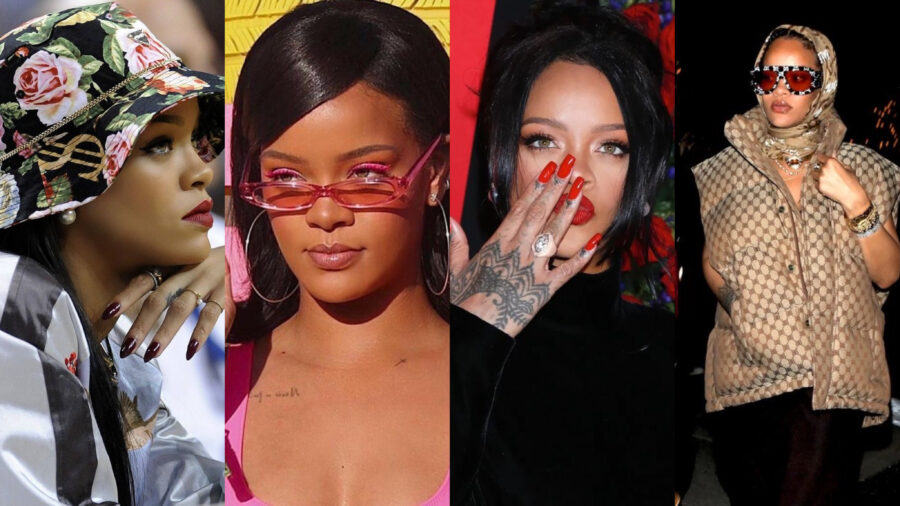Black people have been the blueprint behind many fashion trends you probably didn’t even know about. From inspiring Y2K to high fashion, here are iconic fashion trends that you have black people to thank for.
Hoop Earrings
Hoop earrings have been a staple in the Black community for years even dating back to fourth century Nubia, an African civilization located in what we now call Sudan. During the rise of rap and hip-hop culture in the 80s, hoop earrings got thicker and grew in size. This birthed the “door-knocker” and bamboo style of the hoop. In the 1990s, hoop earrings evolved into the form of large hoops with nameplates or gemstones.
Missy Elliott, Lil Kim, Aaliyah, and Lauryn Hill among others, contributed to the popularization of hoops. This era paved the way for the continuation of this trend from the early 2000s to the present day. Hoop earrings have long been labeled “ghetto” when worn by Black people, despite their popularity. The media celebrates white counterparts for wearing the popular accessory devaluing the importance the accessory serves in the Black community. Next time you wear a pair of hoop earrings consider the cultural history behind them.
Nameplate Necklaces
Nameplate necklaces originated in the 1970s and 80s New York, in Black and Brown communities. It was a way for Black and Brown people to showcase their “hard to pronounce” names. Nameplates united the communities and their cultures by embracing the individuality behind their names. Despite the popularity of these necklaces in these marginalized communities, nameplate necklaces faced similar negative connotations as hoop earrings. White counterparts gain recognition for a trend attributed to Black culture.
In 2004, the popular HBO series “Sex and the City” followed a major plotline in which the show’s main character, Carrie Bradshaw, loses her $125 scripted ‘Carrie’ necklace. This caused controversy at the time. The show chose to showcase Carrie’s white narrative behind “nameplates” instead of giving recognition to the Black and Brown communities in New York.
Logomania
Logomania was birthed as a streetwear style in 1980s, Harlem, New York, when Black boutique owner, Dapper Dan began using fabrics enveloped in knockoff designer logos to style popular hip-hop artists. Dan created clothing, car covers, curtains, and furniture covered in faux designer brands like Gucci and Louis Vuitton. Dan received wide support from many top-name artists like Jay-Z, P Diddy, LL Cool J, and Floyd Mayweather. In 1992, Dan was put out of business due to legal copyright issues. This wasn’t the last we would see of the streetwear pioneer. Dan returned to the fashion scene in 2017 establishing a long-term partnership with Gucci.
Acrylic Nails
The history of nails dates back to 3000 BC. Egyptian women used to wear artificial nails made out of ivory, bone, and gold. In the 14th century, Queens Cleopatra and Nefertiti were celebrated for wearing colored polish on their nails. Black women popularized acrylic nails in the 1970s, influenced by Black 70s Disco stars like Diana Ross and Donna Summers.
During the 1988 Olympics, Black American track and field athlete, Florence Griffith Joyner (aka Flo Jo) set the 100m and 200m world record, declaring her the fastest woman at the time. Flo Jo was not only known for her record-breaking speed but her eclectic acrylic nails. Flo Jo’s influence in popularizing the long acrylic trend in Black history can be seen in American track and field athlete, Sha’Carri Richardson. In April 2021, Richardson ran a new personal best of 10.72 seconds, becoming the sixth-fastest woman of all time and the fourth-fastest American woman in history, all while sporting a set of long acrylic nails.
Sneaker Culture
Sneaker culture premiered in 1980s America as a result of the increasing rise in popularity of hip-hop and basketball. In 1985, famous Black basketball player, Michael Jordan, collaborated with Nike to create the Air Jordan. This shoe revolutionized sneaker culture forever. The rise in popularity of the Air Jordan birthed a generation of sneaker collectors elevated by the success of the shoe in the hip-hop/rap world. Today, sneaker culture has increased, with people labeling themselves as “sneakerheads” – sneaker enthusiasts who collect and resell rare coveted sneakers. Sneakers aren’t going anywhere anytime soon. The trend remains a vital part of streetwear today.
Bucket Hats
Before the Black community revamped the dull hat into a trendy style, bucket hats were once known as fisherman hats. Due to the emergence of hip-hop in the 1980s and 90s, bucket hats rose to popularity in the Black community. Rappers such as LL Cool J, Jay-Z, and Biggie Smalls could be spotted sporting the trendy accessory. Since then, bucket hats continued to rise in mainstream fashion. Designer brands like Prada have even showcased the style on the runway. Bucket hats continue to be popular with celebrities like Rihanna who is seen sporting the style regularly.
Lettuce Hem
In the 1970s, African-American designer Stephen Burrows, invented the popular stitching style we know today as the lettuce hem. The stitching style resembles the look of a lettuce leaf. With the rise of disco in the 70s, the flowy movement of the lettuce hem helped popularize the new style trend. Along with the Y2K fashion resurgence, lettuce hem can be easily spotted today in tops, dresses, and pants.
Streetwear
The most notable influence to come from Black people to fashion is the birth of streetwear. Streetwear is commonly attributed to the emergence of 1980s and 1990s hip-hop/rap culture. Streetwear has birthed many subcultures of popular fashion trends today such as sneaker culture, logo-mania, and Y2K.
What fashion trend from Black culture is your favorite? Lets us know in the comments.
If you want to read more stories like this, follow MEFeater on Twitter, Instagram, Facebook, and Pinterest for more content!
